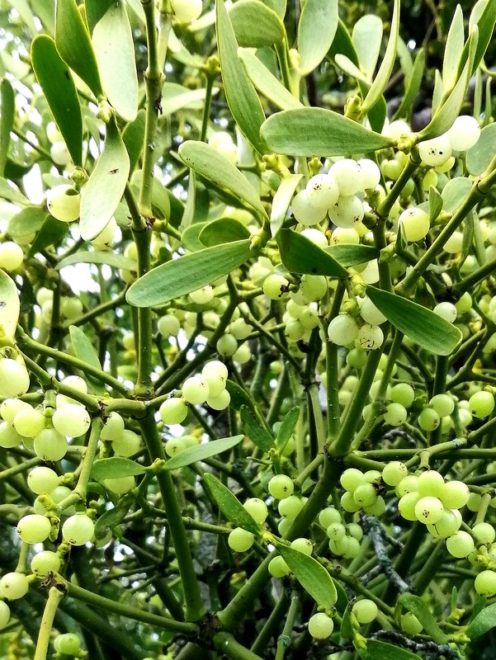Festive Fronds – Plants of the Park
December 2, 2019
From Kate Frankland, Volunteer Ranger, Eastern Downs
Mistletoe, Viscus album, a woody, parasitic shrub native to Britain is found locally in Sussex but more frequently in the west of the county. Although mistletoe is parasitic it seldom kills its host if kept in bounds by harvesting. It has been cultivated since at least the 18th century. Nurserymen still supply it growing on apple trees.
It is found most often in orchards, parklands, gardens and churchyards and is therefore commonly associated with areas of human habitation on cultivated or deliberately planted trees. It is impossible to know how many specimens have been deliberately cultivated, but clumps in high branches of tall trees are likely to have been sown by birds.
 In Sussex there are colonies of mistletoe on parkland lime trees in Parham Park, Cowdray Park, Petworth Park and Lavington Park. At Parham it also grows on ancient hawthorns. In the mid-nineteenth century mistletoe was so abundant in Cowdray Park that cartloads were cut before Christmas.
In Sussex there are colonies of mistletoe on parkland lime trees in Parham Park, Cowdray Park, Petworth Park and Lavington Park. At Parham it also grows on ancient hawthorns. In the mid-nineteenth century mistletoe was so abundant in Cowdray Park that cartloads were cut before Christmas.
Mistletoe can occur on up to 200 species of trees although rarely on conifers. Apple is the most common host, but it also occurs on lime, hawthorn, crack willow, poplar, robinia, field maple, sycamore, elm, horse chestnut, ash, whitebeam and rowan.
Try growing your own:
- a mature host tree with thin bark is best,
- rub a ripe berry onto the underside of a strong branch and tie securely with muslin,
- if it ‘takes’ the root will penetrate the host tree and shoot
- male and female plants are needed near to each other to produce berries
- flowers form slowly over several months and open around February. They are pollinated by insects, particularly bees, as in other fruiting plants
- berries can take up to a year to ripen.
If you know of mistletoe plants growing in your area, the Sussex Botanical Recording Society would love to hear from you with a grid reference if possible.
